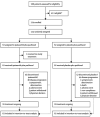Ipatasertib plus paclitaxel versus placebo plus paclitaxel as first-line therapy for metastatic triple-negative breast cancer (LOTUS): a multicentre, randomised, double-blind, placebo-controlled, phase 2 trial
- PMID: 28800861
- PMCID: PMC5626630
- DOI: 10.1016/S1470-2045(17)30450-3
Ipatasertib plus paclitaxel versus placebo plus paclitaxel as first-line therapy for metastatic triple-negative breast cancer (LOTUS): a multicentre, randomised, double-blind, placebo-controlled, phase 2 trial
Erratum in
-
Correction to Lancet Oncol 2017; 18: 1360-72.Lancet Oncol. 2018 Dec;19(12):e667. doi: 10.1016/S1470-2045(18)30845-3. Lancet Oncol. 2018. PMID: 30507431 No abstract available.
Abstract
Background: The oral AKT inhibitor ipatasertib is being investigated in cancers with a high prevalence of PI3K/AKT pathway activation, including triple-negative breast cancer. The LOTUS trial investigated the addition of ipatasertib to paclitaxel as first-line therapy for triple-negative breast cancer.
Methods: In this randomised, placebo-controlled, double-blind, phase 2 trial, women aged 18 years or older with measurable, inoperable, locally advanced or metastatic triple-negative breast cancer previously untreated with systemic therapy were recruited from 44 hospitals in South Korea, the USA, France, Spain, Taiwan, Singapore, Italy, and Belgium. Enrolled patients were randomly assigned (1:1) to receive intravenous paclitaxel 80 mg/m2 (days 1, 8, 15) with either ipatasertib 400 mg or placebo once per day (days 1-21) every 28 days until disease progression or unacceptable toxicity. Randomisation was by stratified permuted blocks (block size of four) using an interactive web-response system with three stratification criteria: previous (neo)adjuvant therapy, chemotherapy-free interval, and tumour PTEN status. The co-primary endpoints were progression-free survival in the intention-to-treat population and progression-free survival in the PTEN-low (by immunohistochemistry) population. This ongoing trial is registered with ClinicalTrials.gov (NCT02162719).
Findings: Between Sept 2, 2014, and Feb 4, 2016, 166 patients were assessed for eligibility and 124 patients were enrolled and randomly assigned to paclitaxel plus ipatasertib (n=62) or paclitaxel plus placebo (n=62). Median follow-up was 10·4 months (IQR 6·5-14·1) in the ipatasertib group and 10·2 months (6·0-13·6) in the placebo group. Median progression-free survival in the intention-to-treat population was 6·2 months (95% CI 3·8-9·0) with ipatasertib versus 4·9 months (3·6-5·4) with placebo (stratified hazard ratio [HR] 0·60, 95% CI 0·37-0·98; p=0·037) and in the 48 patients with PTEN-low tumours, median progression-free survival was 6·2 months (95% CI 3·6-9·1) with ipatasertib versus 3·7 months (1·9-7·3) with placebo (stratified HR 0·59, 95% CI 0·26-1·32, p=0·18). The most common grade 3 or worse adverse events were diarrhoea (14 [23%] of 61 ipatasertib-treated patients vs none of 62 placebo-treated patients), neutrophil count decreased (five [8%] vs four [6%]), and neutropenia (six [10%] vs one [2%]). No colitis, grade 4 diarrhoea, or treatment-related deaths were reported with ipatasertib. One treatment-related death occurred in the placebo group. Serious adverse events were reported in 17 (28%) of 61 patients in the ipatasertib group and nine (15%) of 62 patients in the placebo group.
Interpretation: Progression-free survival was longer in patients who received ipatasertib than in those who received placebo. To our knowledge, these are the first results supporting AKT-targeted therapy for triple-negative breast cancer. Ipatasertib warrants further investigation for the treatment of triple-negative breast cancer.
Funding: F Hoffmann-La Roche.
Copyright © 2017 Elsevier Ltd. All rights reserved.
Figures




Comment in
-
Targeting PI3K/AKT pathway in triple-negative breast cancer.Lancet Oncol. 2017 Oct;18(10):1293-1294. doi: 10.1016/S1470-2045(17)30514-4. Epub 2017 Aug 8. Lancet Oncol. 2017. PMID: 28800863 No abstract available.
References
Publication types
MeSH terms
Substances
Associated data
Grants and funding
LinkOut - more resources
Full Text Sources
Other Literature Sources
Medical
Research Materials

